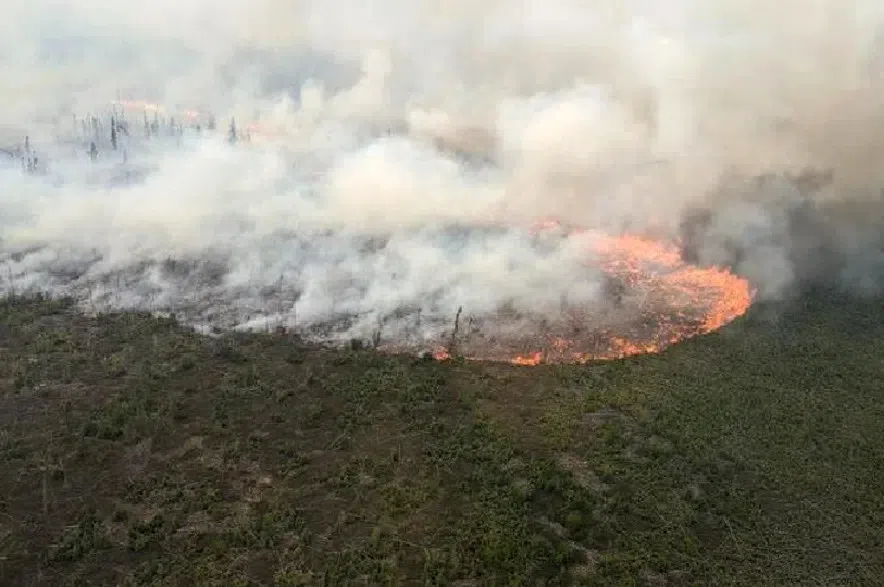New tariffs on softwood lumber imports implemented by the U.S. this week are adding another concern for the industry in Saskatchewan, which was already concerned about its future after this year’s massive wildfire season.
The effective new tariff amount for softwood lumber into the U.S. is 45 per cent, which Carl Neggers said could mean tens of millions of dollars to the industry in this province – he’s the CEO of Forest Saskatchewan, an industry advocacy group.
He said tariffs and duties between the U.S. and Canada have been a common thing when it comes to lumber, but the recent Trump tariffs on finished products like dimensional lumber are affecting Saskatchewan mills significantly.
“We’re not near water, most of our wood has to be trucked, and we are a distance from a lot of the major markets in the U.S. that procure our product,” explained Neggers.
He has sent letters to the province wanting to talk about the industry’s concerns and what Forest Saskatchewan wants the province and federal government to do to help.
Neggers said he wants labour force development and protection, and protection for the current industry and employees.
Read more:
- ‘Razor’s edge of survival’: Eby calls for attention on softwood amid tariff hike
- Carney says renegotiating CUSMA likely won’t resolve all trade issues with U.S.
He suggested diversification of product, like taking Saskatchewan lumber and building pre-fab homes in the province and using them for places like First Nations and communities impacted by wildfires.
When it comes to discussions with the U.S. for an end to the tariffs, Neggers said he wants to be sure it will be a ‘Team Canada’ approach.
“We’re a small market here in Saskatchewan, I mean, we’re big in terms of a provincial market, but in size related to British Columbia, Ontario or Quebec, we’re quite small. We don’t want the bigger provinces taking advantage of our power positions and marginalizing our industry,” he said.
On Wednesday, the federal Industry Minister, Melanie Joly, announced that the government will provide funding for the softwood lumber sector through banks, backstopped by the Business Development Bank of Canada.
It’s meant to make it easier for lumber businesses to access $700 million in new term loans or letters of credit through their primary financial institution.
Joly said it will make sure the businesses can stay afloat, and government will also offer support for operations and capital expenditures. Joly said that would happen while developing and promoting a buy-Canadian policy for projects and infrastructure.
Impact of wildfires
Neggers called the new tariffs death by a thousand cuts, because the industry has already been worrying about the impact of the massive wildfire season this summer.
Normally in a season, Neggers said the province sees a wildfire impact of about 6,000 hectares, but over the last three years, it’s been six million.
This year, he said in the commercial forest areas where the mills are licensed to harvest product, there were almost one million hectares burned. Most of that was in the Prince Albert Forest Management Area, and Neggers said there are a number of mills which harvest there and will really be impacted by the wide fire area.
He said he’s been trying to work on a healthy forest strategy with the provincial government.
“That includes what do we do to make the forest more resilient so it’s less accepting to wildfires – currently we’ve got lots of forest that has aged out, and when a forest ages out it starts to become vulnerable to infestations like disease or insects,” said Neggers.
As part of that, he wants the province’s different ministries and agencies to work more collaboratively together to work on the safety of resources, like forest.
To harvest lumber, a mill needs a license agreement with the province. They can be as long as 20 years, and tell a mill where it can harvest and how much. The mills then use that agreement to go to a bank and get loans to bankroll their operations.
Neggers said how much of the forest has burned threatens the mills’ ability to harvest how much they need to on an annual basis.
“Every company that’s part of our association is nervous about what the impact is from the wildfires,” said Neggers.
Read more:
- There are lessons to be learned from Canada’s wildfire season and evacuations
- Temporary homes in Denare Beach, Creighton provide much-needed relief: Councillor
He’s also concerned about how the provincial government has been handling wildfires and the care afterward.
Neggers said if the province is letting wildfires burn because there aren’t any communities in the area, that’s not helping the industry.
He also explained that, when forests are harvested, the companies have to plant two trees for every one they cut down, and they have to plant the same species. In wildfire areas, Neggers said the province is supposed to do that as well.
“In the past, the province has tended to say ‘we’ll let mother nature take care of it,’ which is problematic because you can get an invasive species that can get in there and then all of a sudden, instead of taking 75 years to recover that wood lot, it might take 250 years,” he said.
Both the companies and the province are doing their assessments right now, according to Neggers, to figure out what burned and what needs to be done about it.
Neggers said he’s set to sit down with a couple of deputy ministers at the end of October, and he wants to get clarity on what they intend to do about reforestation, and what the plan is for the tariff situation. He said businesses need to know whether they need to alter harvest plans for next season and what the province would do to help make that happen.
He said all the companies were already nervous about the wildfires, but now the tariffs are adding on.
“If there’s no budge on relief and there’s very little support from government, each company’s going to have to do an evaluation on is there enough fibre to stay viable, and is there a market price that we can continue to maintain a profit,” said Neggers.
In 2021, the forestry sector in Saskatchewan saw a record $1.8 billion in product sales, a 60 per cent increase from the year before.
According to the Saskatchewan Trade and Export Partnership, in 2023 the province sold $101,638,000 of lumber products into the U.S.











